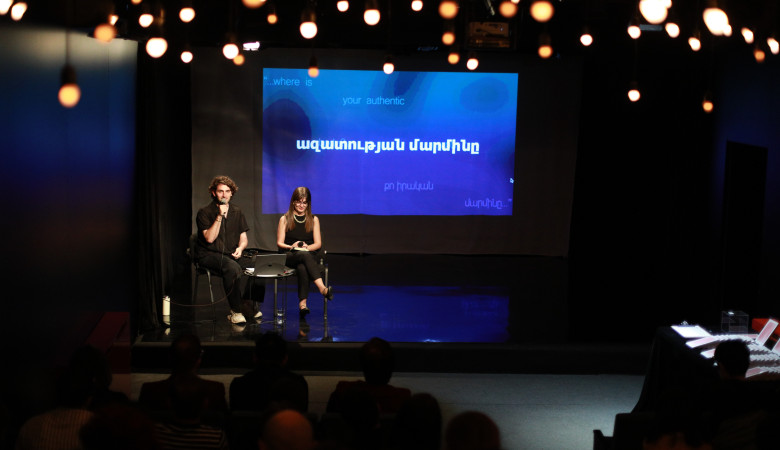Embodied Memories: Yerevan-Berlin PRINTRUN
The “Memory of the Body: Analysing the Representation of the Body in Contemporary Armenian Culture and Art" project studies the representation of the body in contemporary visual and performative arts, focusing on the ways it is depicted as well as the semiotic meanings conveyed to it. The research does not address physical or mental memory itself but rather cultural memory, which acts as an interface and sac for recording various events and their consequences. The project's timeframe spans from the Khrushchev Thaw through the years of Perestroika, including the struggle for independence, the collapse of the Soviet Union, the Nagorno-Karabakh movement, and wars, and extends to the present day. Within the scope of the study, the artworks of artists primarily based in Armenia have been examined, as the representation of the body in diaspora Armenian art is considered a matter of a separate examination.
Each chapter of the book focuses on pivotal events and/or ideological movements that serve as the conceptual foundation for analysing and understanding the roles, symbols, transformations, ways of self-expression, explorations of corporeality, and other manifestations of the body through in-depth reflections within the context of memory studies and cultural anthropology. These include the Soviet discourse around the body, the alternative art of the 1980s, the Nagorno-Karabakh movement, regional conflicts and wars, post-war crises, protests for social justice and democracy, rare artistic instances of reexamining and questioning the Soviet past and current (neo)colonial tendencies, and other key circumstances.
Drawing on the philosophies and approaches of 20th-century theorists such as Roland Barthes, Didier Anzieu, Giorgio Agamben, and others, as well as contemporary Armenian art historians, curators, and critics, the book "Memory of the Body" examines and presents the body as a plural and fragmented palimpsest, that carries the traces of multifarious historical events and imposed identities, incorporates various needs and desires, and ultimately seeks to reclaim its nearly nonexistent presence in contemporary Armenian art and culture.
Rejecting the singularity of the body, the study does not attempt to compare the political body, the body of pleasure, the body of struggle, the body of war, the body of illness, the uncomfortable body, the body of desire, and other diverse bodies with each other. Instead, it examines the cause-and-effect connections that often give rise to very different bodies that nevertheless bear the traces of the same complex past, exercises of forced oblivion, chains, pains, wishes and struggles.
A range of research methods have been applied to execute the project. In particular, the team of cultural researchers and visual artists employed practices such as reviewing existing literature and prior research on the topic, examining digital and personal archives, mapping contemporary Armenian visual and performative artworks created during the research period, conducting in-depth analyses (including semiological, contextual, and comparative), and applying an interdisciplinary approach (cultural anthropology, memory studies), among others.

The “Memory of the Body: Analysing the Representation of the Body in Contemporary Armenian Culture and Art” research addresses several key thematic dimensions including, but not limited to:
-
The plurality of the body as a bearer of myriad pivotal events, identities, characteristics, and signs,
-
The authoritarian and restrictive policy of the Soviet Union regarding the body and its portrayal in art and culture,
-
The role of alternative culture and art in the context of the collapse of the USSR and the establishment of an independent state,
-
The impact of the Karabakh movement, conflict, and wars on the representation of the body in contemporary art and culture,
-
The critical reinterpretation, artistic and cultural reflection of the Soviet legacy, in the context of the post-war crisis,
-
Gender and feminist issues explored through corporeal art and culture,
-
The artistic and cultural resistance to (neo)colonialism,
-
The body that has served various ruling ideologies in different periods of time, including Soviet industrialisation ("body-machine"), nationalism and militarism ("body-sacrifice"), the civil struggle for social justice and democracy ("body-counterattack"), consumerism and mass culture ("body-consumer object"), the patriarchal system ("body-object"), and (de)colonial movements ("body-(de)colonisation"), among others,
-
The multifaceted significance of nakedness and the loss of corporeality of the body in contemporary Armenian art and culture.
In the framework of the project, comprehensive books in Armenian and English have been authored, including various samples of visual artworks that represent the chronological and thematic frameworks of the research.
The project undertaken by the "Cultural and Social Narratives Laboratory" (CSN Lab) around is a rare exploration in the Armenian context, revealing the methods and purposes of body representation in contemporary Armenian visual and performative art and culture. Through this unique endeavour, the project aims to initiate a framework for future studies and artistic reflections by researchers and cultural practitioners, as well as for the formation of public discourse on corporeality in contemporary Armenian art and culture.
The “Memory of the Body: Analysing the Representation of the Body in Contemporary Armenian Culture and Art” project has been implemented by the “Cultural and Social Narratives Laboratory” (CSN Lab) with the financial support of the “Pink” human rights defender NGO and Sweden.



